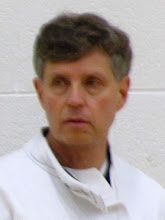Last week
Lynn and I went for a morning walk in the city that ended at a rambling old
bookstore. I’ve always liked morning
city walks; they can be unexpectedly memorable. A particular favorite is a walk I took in
Paris in April after a night of rain. I
left my tiny hotel off the Arc de Triomphe and ended with café au lait at the Café
Deux Magots in La Place-de-Saint-Germain on the Left Bank; neither the beginning nor the end was remarkable
as beginnings and endings sometimes are.
But during the walk I observed the city assembling itself for the day,
not just in obvious things like street washing, garbage collection and
deliveries of everything from dresses to baguettes, but, more interestingly, in
people’s faces. Sometimes the morning expressions
people have as they’re walking to work, or waiting for a shop to open, or
encountering someone unexpected, are more revelatory than the more practiced
expressions later in the day. I expect
that people who run in the morning (I do not) may have a similar experience
although I never feel as observant when I’m running as I wish I did. There’s much to be said for morning walks in
the city.
Last week as we were walking we passed an abandoned department store that had once been one of the most exclusive in the city. At street level it was all graffiti’d, boarded-up windows; the many stories above were only a blank, dirty-white fascia. It was unremarkable, for all practical purposes, invisible. But I remembered going there with my mother as a young child at Christmas, the window displays, an aunt who worked there operating a wrought iron mechanical elevator while she was in college. She always had to wear white gloves. I wondered what it was like inside now. Was it empty? Or perhaps it was full of the detritus of its decades as a store? Was it a suitable subject for some minor Urban Exploration? I imagined contacting a real estate agent, requesting a tour for a future investment. We walked on.
In 2010 my
cousin Robert and I attended a lecture by Professor Graeme W. Milton on “Cloaking,”
or as he put it, the science and maths of making something invisible like a
Romulan space ship in Star Trek. He
discussed new research into bending light and even cancelling light waves, just
as waves on a pond can cancel each other; it’s the same strategy that used in
noise canceling headphones. I was intrigued,
not so much because of the possibility of invisibility but because it might
also solve one of the most important problems for space travel itself: gamma radiation. If gamma rays could be bent around a space
ship, the occupants wouldn’t be forced to travel in uncomfortable lead cocoons,
or something equally implausible, to avoid being slowly roasted.
This week in
the New Yorker Kathryn Schultz picked up the topic of invisibility again,
discussing the manifold variations on the idea, literary precedents back to
Socrates, and alluded to some novel applications. One of the most intriguing is urban planning
and architecture. Why not blend light
around a building or a part of it? Imagine
the cityscapes that could be created. (It
certainly could be used to address the sight-line issue I’ve addressed earlier
in the context of medieval Bologna and modern London.) Naturally, that sent me
off on a web search and I discovered that invisibility is a developing theme in
architecture and that architects are already working to achieve various kinds
of invisibility without the assistance of particle Physics.
Bradley Garret and the Urban Exploration subculture came to mind and I imagined a group of them at some time in the imaginable future attempting to explore a building or even an entire city, interesting portions of which were invisible. It’s good science fiction story material I think.
In her
article, Ms. Schultz observes, “almost everything around us is imperceptible,
almost all the rest is maddeningly difficult to perceive, and what remains
scarcely amounts to anything. Physicists estimate that less than five per cent
of the known universe is visible—where “visible” means only that we could,
theoretically, observe it, given the right instruments and sufficient physical
proximity.” Of that five percent, how
much is invisible simply because we’re indifferent to it or it’s in too common
a context? Invisibility, that innocuous
white building we passed and my personal memories associated with it make me
think Urban Exploration has at least as important a role to play for historians
as geographers.
We arrived
at the bookstore and I was fortunate to find a book long out of print
discussing Hopi culture, some of which now may be hidden away from view.
(A note on my Malory research: a careful look at the life of Sir Humphrey Stafford, 1st Duke of Buckingham is proving more challenging than expected. A study of Parliament in the 15th century has provided a few, possibly pertinent insights but I’m awaiting the arrival of a Stafford biography that may offer more clues.)





No comments:
Post a Comment